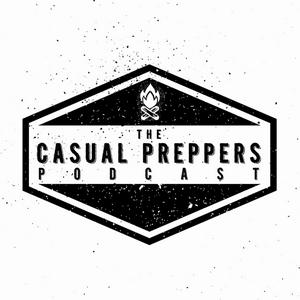382 episodios

The Prepper Audit
25/12/2025 | 52 min
The Prepper Audit: Are You Actually Ready? 📄 Episode Description It’s easy to call yourself a prepper — it’s harder to prove it. In this episode, Coby and Cam break down the “Prepper Audit”: a brutally honest self-check to find out if you’re actually ready or just feeling ready. We cover the six core areas every prepper should review, the most common weak spots, and simple fixes to get your readiness back on track before an emergency hits. 🧱 Episode Breakdown 🧪 What a Prepper Audit Actually Is Why most people think they’re more prepared than they are. How to check your real readiness instead of your imagined readiness. Why prepping is never “set it and forget it.” 📦 The Six Pillars You Need to Audit Plans — meeting points, comms, routes, contingencies. Gear — functionality, organization, rotation, seasonality. Skills — fire, water, first aid, comms, navigation, drills. Health & Fitness — physical ability, medical needs, mental resilience. Finances — savings, cash, debt, documents, insurance. Mindset — calm under pressure, adaptability, realistic planning. 🛠️ How to Actually Do the Audit Score yourself 1–5 in each category. Document weak spots with notes and photos. Set small improvement goals instead of massive overhauls. Make it a yearly habit. 🚨 Common Weak Spots (Prepare to Feel Attacked) Expired food, dead batteries, untested generators. Plans nobody else in the family knows. Overloaded bug-out bags. Medical gaps and neglected mental readiness. 🔧 Simple Fixes That Make a Huge Difference Work one category per month. Rotate your storage — use what you store. Train for free using community resources. Stay humble and make preparedness a habit, not a hobby. 🎙️ Podcast Sponsors BattlBox Get 15% off your first box of solid outdoor, survival, and EDC gear. 👉 https://Survive.BattlBox.com/CasualPreppers LMNT Electrolytes Get a FREE LMNT Sample Pack with any purchase using our exclusive CPP link. 👉 https://DrinkLMNT.com/CasualPreppers ReadyPlan by M.A.D. Gear The digital emergency planning app that helps you build, organize, and share your preparedness plans. Use code CASUALPREPPERS for a discount. 👉 Available in all app stores — search ReadyPlan by MAD Gear #StaySurvived

MB 138 - Q&A
18/12/2025 | 43 min
Mindless Banter 138 - Q&A It’s another wild Casual Preppers Q&A where we tackle everything from surviving a zombie apocalypse using only what's in our studio… to the fate of This Podcast Is a Secret, the best SHTF event to live through, basic preps people always overlook, and whether you should take the bike path or the highway during an EMP. We hit gear that surprised us, gear that turned out useless, real-life strange things we’ve seen in the Uintah Basin, and why emergency plans beat almost anything in your prep. It’s chaos, it’s practical, and it’s exactly what makes these Q&As fun. Sponsors: BattlBox – 15% off your first box: Survive.BattlBox.com/CasualPreppers LMNT – Free sample pack with any purchase: DrinkLMNT.com/CasualPreppers TacPack – FREE $70 part with code CASUALPREPPERS

The Suburban Prepper
11/12/2025 | 47 min
The Suburban Prepper Suburban preppers live in the in-between: not off-grid, not downtown, but right where most emergencies actually hit. In this episode, we break down the real advantages of suburbia—access to supplies, easier home security, and a built-in neighborhood network—along with the challenges of HOAs, low privacy, and relying on fragile city infrastructure. It’s all about prepping quietly, smartly, and using the “middle ground” to your advantage. Sponsors: BattlBox – 15% off your first box: Survive.BattlBox.com/CasualPreppers LMNT – Free sample pack with any purchase: DrinkLMNT.com/CasualPreppers ReadyPlan by MAD Gear – Organize your emergency plans: (Search “ReadyPlan by MAD Gear” in your app store)

Surviving Disasters Past: The Mt. St. Helens Eruption
04/12/2025 | 27 min
Surviving Disasters Past – Mount St. Helens Eruption, 1980 📄 Episode Description In this episode, we look back at the 1980 eruption of Mount St. Helens — one of the most violent volcanic explosions in U.S. history. We talk through the months of warning signs leading up to the blast, the massive bulge that formed on the north side of the mountain, and the political and personal battles over evacuation orders. We walk through the moment the volcano exploded, the landslide that triggered the lateral blast, and how the eruption flattened forests, buried river valleys, and sent ash across 11 states. We also discuss the people who survived, those who didn’t, and how emergency response unfolded in the chaos that followed. Finally, we break down the major preparedness lessons: understanding local hazards, building a 72-hour kit for dirty air, knowing evacuation routes, protecting your water and engines, and staying adaptable when warnings shift from “someday” to “right now.” 🧱 Episode Breakdown 🌋 The Warnings – Rising earthquakes, steam bursts, and the rapidly growing bulge on the north flank showed the mountain was under extreme pressure, and scientists struggled to communicate the danger to locals and officials. 💥 The May 18 Eruption – A magnitude 5.1 earthquake triggered the largest landslide ever recorded, releasing a sideways blast of ash, gas, and rock that tore through 230 square miles at hundreds of miles per hour and instantly reshaped the mountain. 🌑 Ashfall Across the Northwest – A 15-mile-high ash column darkened the sky, shut down airports, buried roads and farms, clogged engines, and drifted across multiple states, turning day into night. 🌊 Lahars & Destruction – Melted snow and debris produced massive mudflows that destroyed bridges, highways, homes, and entire river valleys, causing long-term disruptions to power, water, and transportation. 🧍 Human Stories & Loss – Fifty-seven people died, including scientists, campers, and residents who chose to stay behind. We discuss the famous last transmission from volcanologist David Johnston and the story of Harry Truman, who refused to evacuate Spirit Lake. 🏚 Aftermath & Recovery – Cleanup went on for months as ash was shoveled like snow, respirators became everyday gear, and the region worked to rebuild roads, utilities, and entire communities while adapting to a transformed landscape. 🧭 Preparedness Lessons – Why early evacuation matters, how respiratory protection can save lives, why engines fail in heavy ash, how long-term outages can follow volcanic events, and why adaptability—not prediction—is a prepper’s best tool. 🎧 Podcast Sponsors BattlBox – 15% off your first box at Survive.Battlbox.com/casualpreppers LMNT – Free sample pack with any purchase at DrinkLMNT.com/CasualPreppers TacPack – Use code CASUALPREPPERS for a free $70 Next Level Armament part #StaySurvived

Surviving Disasters Past: The Great Midwest Flood of 93
27/11/2025 | 37 min
Surviving Disasters Past – The Great Midwest Flood, 1993 We wrote a book… for kids. How to Survive an Apocalypse. 📄 Episode Description In this episode, we break down the Great Midwest Flood of 1993 — the costliest, longest-lasting flood in U.S. history. We talk about how a brutal winter and an unusually wet spring set the stage for disaster, how months of nonstop rain overwhelmed levees and entire river systems, and how communities fought to survive when the water simply refused to go down. We cover the collapse of infrastructure, the massive evacuations, the contamination and health issues, and what life was like in towns that stayed underwater for months. Finally, we pull out the biggest preparedness lessons from 1993: knowing your real flood risk, protecting drinking water, waterproofing your kits, elevating utilities, planning for early evacuation, and preparing for long-term displacement when a disaster drags on far longer than expected. 🧱 Episode Breakdown 🌧 The Setup & Rise of the Floodwaters – How snowpack, spring saturation, and relentless summer storms combined into one of the worst hydrological events the U.S. has ever seen, and why levees up and down the Mississippi and Missouri were doomed to fail. 🏚 Communities Underwater – Stories of towns completely submerged, residents evacuating by boat and tractor, and the emotional toll of watching neighborhoods disappear and staying displaced for weeks or months. ⚠️ Infrastructure Collapse – What happens when bridges, roads, crops, rail lines, power plants, and water treatment systems all fail at once—and why Des Moines lost its drinking water for nearly two weeks. 🧫 Health & Environmental Hazards – How chemical leaks, sewage contamination, mold, and stagnant water created major public-health crises long after the rain stopped. 💧 Survival Lessons from 1993 – The importance of not relying on levees, understanding your elevation, keeping clean water stored, securing sanitation, using generators safely, and maintaining morale during a long-duration disaster. ⚙️ Modern Prepper Takeaways – Waterproof your 72-hour kit, elevate home utilities, know how to shut off gas and power, keep flood-fighting tools ready, treat cleanup like hazmat, and remember that some disasters build slowly until normal life disappears. 🌊 Anytime Flooding Threatens – Why forecasts matter, why you never drive into floodwater, how to protect valuables and drinking water, how to stay safe post-flood, and what gear is worth keeping if you live in flood-prone regions. 🎧 Podcast Sponsors BattlBox – 15% off your first box at Survive.Battlbox.com/casualpreppers LMNT – Free sample pack with any purchase at DrinkLMNT.com/CasualPreppers MAD Gear ReadyPlan App – Use code CASUALPREPPERS for a discount #StaySurvived
Más podcasts de Humor
Podcasts a la moda de Humor
Acerca de Casual Preppers Podcast - Prepping, Survival, Entertainment.
Escucha Casual Preppers Podcast - Prepping, Survival, Entertainment., Hora Veintipico y muchos más podcasts de todo el mundo con la aplicación de radio.es

Descarga la app gratuita: radio.es
- Añadir radios y podcasts a favoritos
- Transmisión por Wi-Fi y Bluetooth
- Carplay & Android Auto compatible
- Muchas otras funciones de la app
Descarga la app gratuita: radio.es
- Añadir radios y podcasts a favoritos
- Transmisión por Wi-Fi y Bluetooth
- Carplay & Android Auto compatible
- Muchas otras funciones de la app


Casual Preppers Podcast - Prepping, Survival, Entertainment.
Descarga la app,
Escucha.






































